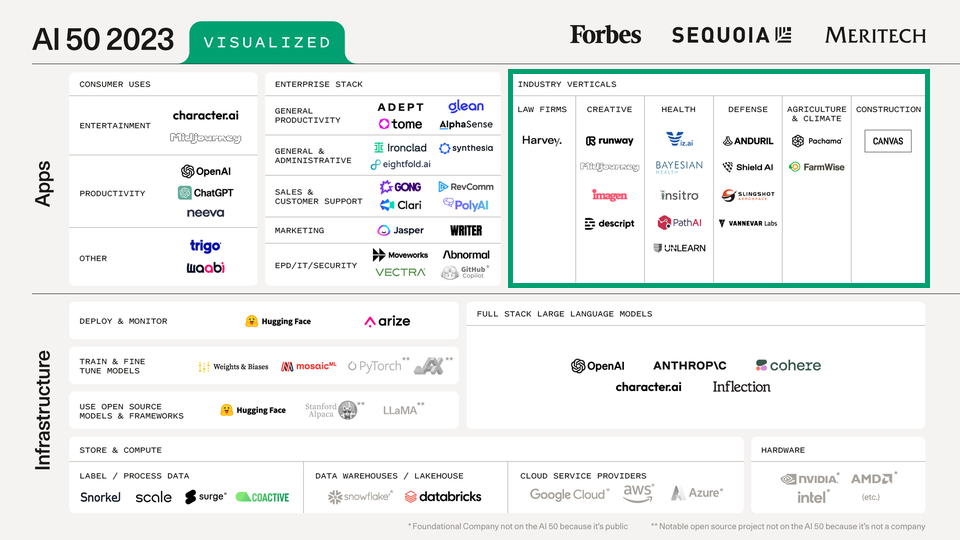Written by Cindy Gamal, in collaboration with Kevin Nguyen.
AI has taken the world by storm, from chatbots to business email generators. However, the current landscape might not be the final destination in the AI revolution. The true winners could be the domain-specific, verticalized AI models that are starting to emerge. In this article, we’ll explore the two horizons of AI development and delve into the significance of going vertical.
The First Horizon – General
Generative AI has captured the attention of venture capitalists and SaaS startup founders. The potential for innovation and disruption offered by generative AI has led to increased investments and partnerships in this domain.
The best time to build and invest in generative AI is when the technology is validated but its full range of business applications remains untapped. Founders and investors who recognize this moment can position themselves to benefit from generative AI’s transformative power and be a pioneer in this budding space, driving innovation and commercialization across various industries.
Currently, the generative AI landscape is dominated by popular products like Jasper, Midjourney, and CoPilot. These models excel in breadth of use, distribution and user-friendliness, but their drawback lies in their lack of deep domain knowledge. We find this limits the depth and complexity of their application.
The Second Horizon – Vertical

Image adapted from Sequoia Capital, Forbes and Meritech
You’re too late for the general-use AI products. This is the gap you can enter instead: Verticalization.
To overcome limitations and advance the field of AI, the second horizon of AI development focuses on verticalization, which involves tailoring AI to specific industries and integrating it into business processes. As Large Language Models (LLM) usage matures, we will see more companies building their own, highly specific, and remarkably efficient models. This transition presents a golden opportunity for those seeking to enter the AI landscape, as the general-use AI products start to define their winners. This angel also builds a strong defensible moat, both from the data and the AI model aspects. BloombergGPT, focused on financial language processing, serves as an excellent example of this trend.
Another approach in verticalization is through training the model on non-dialect languages (i.e. not any human communication language) like genetic code or protein folding. AI’s ability to analyze and iterate on the level of detail in a language that’s largely “unnatural” to humans, businesses can save time and costs, solve long-standing problems, and even create entirely new ways of doing things that were previously impossible. Let’s explore 2 examples with protein folding and weather forecasting.
In the field of protein engineering, David Baker and his team at the University of Washington utilized AI to design customized, functional proteins that could be synthesized and manufactured in live cells. This breakthrough opens up new avenues for protein engineering, presenting significant possibilities in industrial and medical applications.
On the weather forecasting front, Huawei’s Pangu-Weather demonstrates the potential to accelerate the forecasting process and improve accuracy, particularly in predicting extreme rainfall. This AI model leverages 39 years of reanalysis data, combining historical weather observations with modern models, to enhance its weather predictions.
Looking Ahead
Looking ahead, the future of AI lies in going vertical. By focusing on deep domain knowledge and embedding AI within specific industries, we can overcome the limitations of generic models and deliver specific, accurate, and contextually relevant outputs. By founding your company at this stage, you can ride the waves of market trends and technological innovation, securing a strong position in the market.
In summary:
- The first horizon of AI development focuses on general-purpose AI models, attracting investments and partnerships but lacking deep domain knowledge.
- The second horizon emphasizes verticalization, tailoring AI to specific industries, and integrating it into business processes.
- The competitive opportunity lies in verticalization. You can tailor AI to specific industries by various ways including customization or building specific language models or training AI on non-dialect languages.
If you have ideas or an interest in this space, feel free to reach out to us at cindy.gamal@futuresight.ventures. Together, let’s shape the future!
